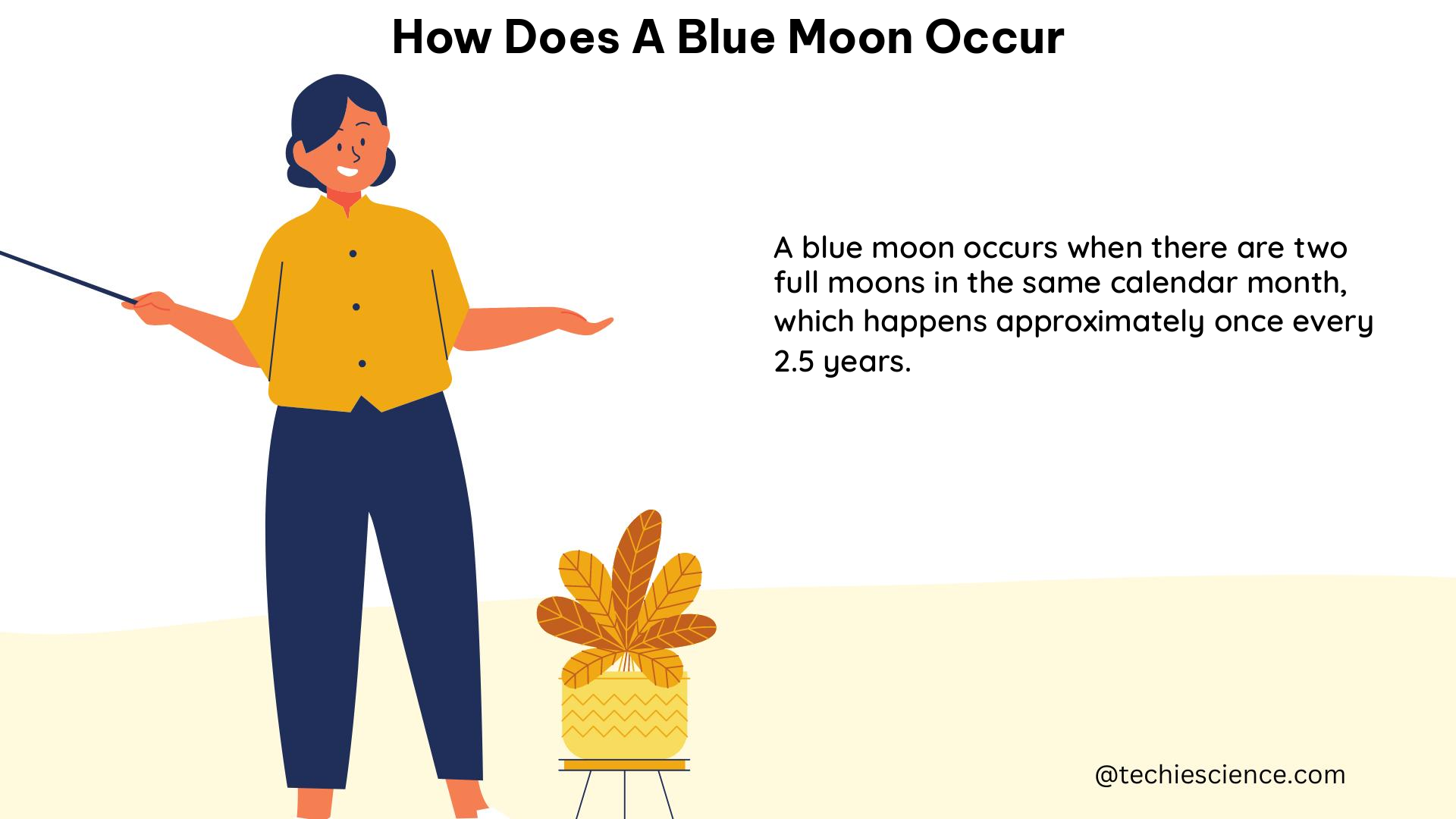A blue moon is a rare astronomical event that occurs when there are two full moons in a single calendar month. This phenomenon is primarily due to the mismatch between the length of the lunar cycle and the length of a calendar month. In this comprehensive guide, we will delve into the intricate details of how a blue moon occurs, exploring the underlying physics and providing a wealth of technical information to satisfy the curiosity of physics students.
Understanding the Lunar Cycle
The lunar cycle, also known as the synodic month, is the time it takes for the Moon to complete one full cycle of phases, from new moon to new moon. This cycle is approximately 29.53 days long, which is slightly shorter than the average length of a calendar month (28-31 days).
The formula for calculating the length of the lunar cycle is:
Lunar Cycle Length = 29.53059 days
This slight discrepancy between the lunar cycle and the calendar month is the primary reason why blue moons occur.
Defining a Blue Moon

A blue moon is defined as the second full moon that occurs within a single calendar month. This definition was established in the 1940s, following a misinterpretation of the original meaning of the term “blue moon.”
Historically, the term “blue moon” was used to refer to the third full moon in a season with four full moons, rather than the traditional three. However, this original definition was often misunderstood, leading to the current definition of a blue moon as the second full moon in a calendar month.
The Frequency of Blue Moons
Blue moons are relatively rare events, occurring approximately once every 2.7 years, or about seven times every 19 years. This frequency can be calculated using the following formula:
Blue Moon Frequency = 1 / (12 / 29.53059) = 2.7 years
The reason for this frequency is that the lunar cycle of 29.53 days is slightly shorter than the average length of a calendar month (30.4375 days). This means that, on average, there are 12.37 full moons in a year, which results in a blue moon occurring once every 2.7 years.
Timing and Time Zones
The timing of a blue moon can vary depending on the time zone in which it is observed. This is because the moment of the full moon is determined by the Moon’s position relative to the Earth and the Sun, which is not affected by time zones.
For example, if the first full moon of a month occurs at the end of the month in one time zone, it may not be considered a full moon in a time zone more than one time zone to the west. This can lead to a situation where a blue moon is observed in one time zone but not in another.
To illustrate this, let’s consider a hypothetical scenario:
| Time Zone | First Full Moon | Second Full Moon | Blue Moon Observed? |
|---|---|---|---|
| Eastern Time (ET) | January 1st, 11:59 PM | January 31st, 12:01 AM | Yes |
| Central Time (CT) | January 1st, 10:59 PM | January 31st, 11:01 PM | No |
In this example, the first full moon occurs at the end of the month in the Eastern Time zone, while the second full moon occurs at the beginning of the next month in the Central Time zone. As a result, a blue moon is observed in the Eastern Time zone but not in the Central Time zone.
The Rarity of Black Moons
In addition to blue moons, there is another rare astronomical phenomenon known as a “black moon.” A black moon occurs when there is no full moon in a calendar month, which can only happen in February.
The reason for this is that February is the only month with fewer than 29 days (28 days in a regular year, 29 days in a leap year). Since the lunar cycle is approximately 29.53 days, it is possible for a month to have no full moons at all.
Black moons are even rarer than blue moons, occurring only four times in the 21st century:
- February 2018
- February 2037
- February 2054
- February 2067
Factors Affecting Blue Moon Visibility
While the occurrence of a blue moon is a predictable astronomical event, its visibility can be affected by various environmental factors. These factors include:
-
Atmospheric Conditions: The appearance of the moon can be influenced by the composition and density of the Earth’s atmosphere. Certain atmospheric conditions, such as the presence of dust or water vapor, can scatter specific wavelengths of light, causing the moon to appear blue or even red.
-
Lighting Conditions: The brightness and color of the moon can be affected by the position of the Sun relative to the Earth and the Moon. For example, a full moon near the horizon may appear more reddish due to the longer path the light must travel through the atmosphere.
-
Observational Conditions: The location and time of observation can also impact the visibility of a blue moon. Factors such as cloud cover, light pollution, and obstructions in the line of sight can all affect the ability to observe the moon clearly.
Numerical Examples and Calculations
To further illustrate the concepts discussed, let’s consider a few numerical examples and calculations related to blue moons:
- Calculating the Next Blue Moon:
- The last blue moon occurred on August 31, 2023.
- The lunar cycle length is 29.53059 days.
-
The next blue moon will occur on July 31, 2024, approximately 335 days after the previous one.
-
Determining the Frequency of Blue Moons:
- The lunar cycle length is 29.53059 days.
- The average length of a calendar month is 30.4375 days.
- The number of full moons in a year is 12.37 (365.25 days / 29.53059 days).
-
The frequency of blue moons is 1 / (12.37 / 12) = 2.7 years.
-
Calculating the Timing of a Blue Moon:
- The first full moon of a month occurs on January 1st at 11:59 PM in the Eastern Time zone.
- The second full moon of the same month occurs on January 31st at 12:01 AM in the Eastern Time zone.
- In the Central Time zone, the first full moon occurs at 10:59 PM on January 1st, and the second full moon occurs at 11:01 PM on January 31st.
- Therefore, a blue moon is observed in the Eastern Time zone but not in the Central Time zone.
These examples demonstrate the intricate calculations and considerations involved in understanding the occurrence and timing of blue moons.
Conclusion
In this comprehensive guide, we have explored the intricacies of how a blue moon occurs, delving into the underlying physics and providing a wealth of technical details for physics students. From understanding the lunar cycle and the definition of a blue moon to calculating its frequency and timing, this guide has covered a wide range of topics to satisfy the curiosity of those interested in this rare astronomical phenomenon.
By understanding the factors that contribute to the occurrence of a blue moon, physics students can gain a deeper appreciation for the complex interplay between celestial bodies and the impact of time zones on astronomical observations. This knowledge can be further applied to other areas of physics, such as orbital mechanics and the study of the Earth-Moon system.
Remember, the key to mastering the concept of a blue moon lies in the ability to apply the principles of physics and mathematics to real-world scenarios. By working through the examples and calculations presented in this guide, you can develop a robust understanding of this fascinating astronomical event.
Reference:
– NASA – What is a Blue Moon?
– EarthSky – What is a Blue Moon?
– Time and Date – Blue Moon

I am Raghavi Acharya, I have completed my post-graduation in physics with a specialization in the field of condensed matter physics. I have always considered Physics to be a captivating area of study and I enjoy exploring the various fields of this subject. In my free time, I engage myself in digital art. My articles are aimed towards delivering the concepts of physics in a very simplified manner to the readers.